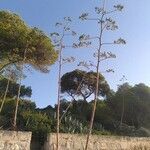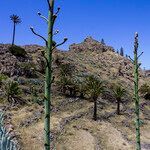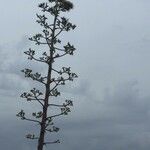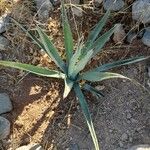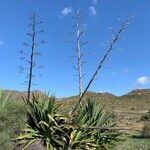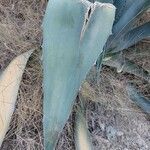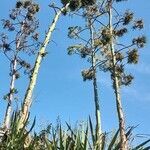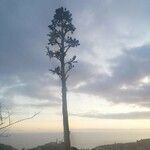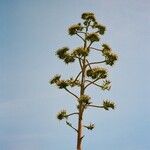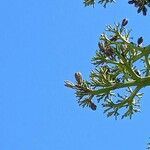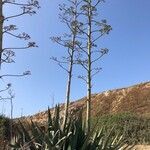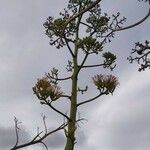Plant large, succulent, freely suckering. Rosettes 1–2 m high, 2–3.7 m wide. Leaves lanceolate, straight or reflexed (often at apex), 100–200 cm long, 15–25 cm wide, light grey-glaucous to light green; margin undulate, straight or crenate, toothed, teeth 5–10 mm long, 2–6 cm apart, brown to pruinose-grey; terminal spine conical to subulate, 3–5 cm long, shiny brown to pruinose-grey. Inflorescence 5–9 m high; scape with triangular bracts; panicles with 15–35 umbellate branches in upper ½–⅓ of scape. Flowers 7–10 cm long, long-pedicellate, yellow. Perianth tube 8–20 mm long, funnel-shaped; sepals and petals unequal, 22–35 mm long, linear to lanceolate, cucullate at apex. Filaments 60–90 mm long; anthers 30–36 mm long. Ovary 30–45 mm long. Capsule oblong, 4–6 cm long, 2–2.5 cm diam., shortly beaked. Seeds 7–8.5 mm long, 5–7 mm wide, shiny black. [See also Green (1994: 523–524).]
Acaulescent perennial. Leaves 1-2 m × 15 cm in large basal rosette fleshy, triangular in section, rosette dying after flowering and replaced by several small lateral rosettes; lamina rigid, leathery, glaucous, lanceolate, ± concave, outer often recurved from above middle, tipped by a conical hard stout dark brown or grey spine 2.5 cm long, margins with coarse grey-brown teeth to 5 mm long borne on horny prominences c. 4 cm apart. Panicle large, 1-2 m long, candelabra-like, terminal on stout ± woody scape 7-10 m high (produced rapidly at maturity of plant after 10-15 years' vegetative growth). Flowers many, yellow. Capsule to 5 cm long, oblong. Seeds black.
A perennial plant up to 7.5 m tall and 2.5 m wide. It does not have a trunk and has suckers. The plants have a very sharp and tough spine at the tip of each leaf. The leaves are grey-green and occur in rings at the base. There are spines on the edges of the leaves. There are 5-8 mm long and 2-6 cm apart. The leaves are word shaped and 1-2 m long. The flowers are tubular and yellow-green. These occur on stems 6 m high.
Stems indistinct. Leaves usually 30--40 or more, in a massive basal rosette, oblanceolate, 1--2 m × 15--20 cm, fleshy, margin spiny, apex recurved and tipped with a dark brown spine 1.5--2.5 cm. Panicle many branched, 6--12 m, usually bearing few bulblets after anthesis. Perianth greenish yellow; tube ca. 1.2 cm; lobes 2.5--3 cm. Stamens ca. 2 × as long as perianth. Capsule oblong, ca. 5 cm.
